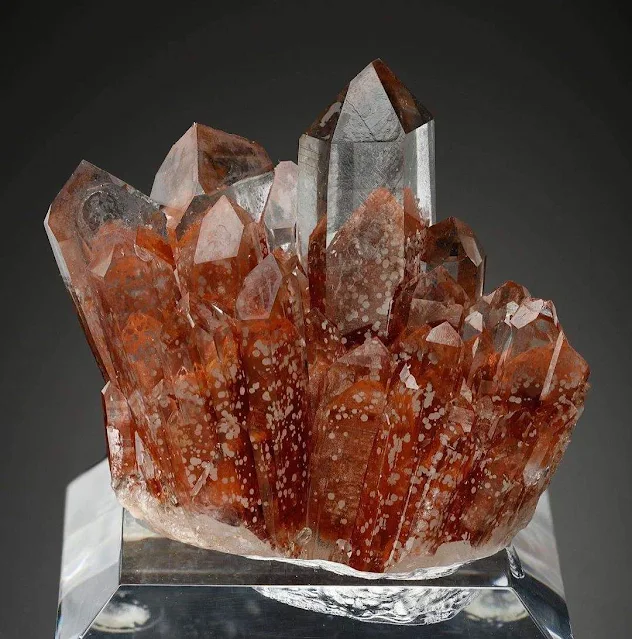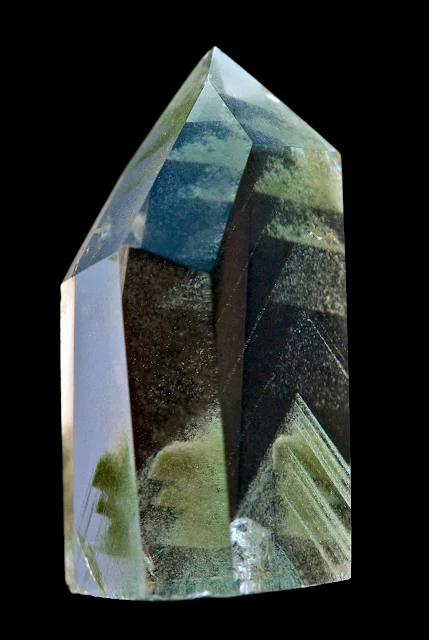Phantom Quartz: Types, Colors, Properties
Phantom quartz is a fascinating variety of quartz characterized by visible layers of overlapping crystal formations. These layers, called phantoms, are formed when the growth of a quartz crystal is interrupted by external factors, such as changes in pressure, temperature, or mineral availability. The interrupted growth creates a new layer, and then growth resumes, encasing the previous layer within the crystal.
Phantom Quartz Formation
Phantom quartz forms when mineral deposits interrupt the growth of a quartz crystal. These deposits later become encased within the crystal as it resumes growth, creating the layered effect. This process can occur multiple times, resulting in multiple phantom layers within the same crystal.
 |
| Red and Green Phantom Quartz Green Phantom quartz by: Crystal Banner Red Phantom Quartz by: Heritage 1971 |
Phantom Quartz Varieties and Types
Phantom Quartz can be found in various colors, including clear, smoky, amethyst, and citrine. Each color carries its own properties and associations, adding another layer of depth to these stones.
Green Phantom Quartz
Green phantom quartz is a variety of phantom quartz with green phantoms inside. The green color is usually caused by the presence of inclusions of chlorite, actinolite, or other green minerals.
Red Phantom Quartz
Red phantom quartz is a variety of phantom quartz with red phantoms inside. The red color can be caused by various minerals, including iron oxides, hematite, or cinnabar.
 |
| Phantom Quartz, from Jessieville, Arkansas Photo: Mineraligned |
Phantom Quartz Properties
Composition: Silicon dioxide (SiO2) - Same as regular quartz.
Color: Can vary depending on the type of quartz it's formed with. Common colors include:
- Clear: With transparent phantoms of smoky quartz or amethyst.
- Smoky: With darker phantoms, sometimes almost black.
- Citrine: With yellow or honey-colored phantoms.
- Amethyst: With purple or lilac phantoms.
Luster: Vitreous - Glassy shine.
Crystal System: Trigonal - Same as regular quartz.
Streak: White - Same as regular quartz.
Hardness: 7 on the Mohs scale - Similar to regular quartz, making it a relatively hard and durable stone.
Cleavage: None - Does not cleave easily.
Crystal Form: Usually found as double-terminated crystals or clusters. The phantoms inside can exhibit interesting shapes and patterns.
Density: 2.65 g/cm³ - Slightly denser than regular quartz.
Transparency: Can range from transparent to translucent, depending on the clarity of the quartz and the density of the phantoms.
Fracture: Conchoidal - Breaks with smooth, curved surfaces.
Solubility: Insoluble in most common solvents, but will dissolve in hydrofluoric acid.
Magnetism: Non-magnetic - Does not attract or repel magnets.
Fluorescence: May fluoresce weakly under long-wave ultraviolet light, depending on the type of quartz it's formed with.
Pleochroism: Weak - May show very slight variations in color depending on the viewing angle.
Refractive Index: 1.544-1.553 - Slightly higher than regular quartz due to the higher density of the phantoms.
 |
| Phantom Quartz from the Orange River area in South Africa, displaying beautiful orange-brown Hematite and Goethite phantoms. Photo: Geocrystals |
Where to Find Phantom Quartz
Phantom Quartz can be found in a variety of locations around the world, but some regions are known for producing particularly beautiful or interesting specimens. Here are some of the most popular sources:
Brazil: Minas Gerais state is a hotspot for Phantom Quartz, especially smoky phantoms and citrine phantoms. The town of Teófilo Otoni is particularly famous for its "Lemurian Seed Quartz," which often contains phantoms.
Madagascar: Known for its clear Phantom Quartz with amethyst or smoky phantoms.
India: Telangana state offers stunning red Phantom Quartz, while the Himalayas can yield various colored types.
Switzerland: The Alps region produces clear Phantom Quartz with smoky or black phantoms.
United States: Phantom Quartz can be found in various states, including Arkansas, Colorado, and North Carolina. The types and colors vary depending on the location.
 |
| Green Phantom Quartz Photo: _Nora.crystals |
Phantom Quartz Uses
Phantom Quartz has a variety of uses, encompassing both practical and metaphysical applications. Here's a breakdown of the different ways people utilize this captivating crystal:
Practical Uses:
Jewelry: The stunning layered appearance of Phantom Quartz makes it a popular choice for jewelry makers. Its hardness and durability allow it to be cut and polished into various shapes for rings, pendants, bracelets, and earrings.
Decorative Stones: The unique beauty and intriguing formations of Phantom Quartz make it a sought-after addition to collections and home decor. They can be displayed individually, grouped with other crystals, or even incorporated into artistic sculptures or objects.
Gemstone Carvings: Skilled artisans sometimes carve intricate designs or figures into Phantom Quartz, taking advantage of the contrasting layers and inclusions to create captivating pieces.
 |
| Phantom Quartz |
Metaphysical Uses:
Crystal Healing: In crystal healing practices, Phantom Quartz is believed to hold various beneficial properties. Some common uses include:
Personal Growth: It's said to aid in overcoming past emotional blockages, embracing personal transformation, and connecting with one's higher self.
Overcoming Challenges: Its layered structure is associated with facing and overcoming obstacles, promoting resilience and adaptability.
Connecting with the Past: The phantoms are seen as representations of past experiences, helping individuals acknowledge and learn from their history.
Balancing Root Chakra: Some believe it works with the Root Chakra, grounding and stabilizing energy, fostering security and a sense of belon.
Metaphysical Properties of Phantom Quartz
Believed to promote inner growth, spiritual insight, and past life recall. Also said to help release past traumas and negativity.
- General properties:Promotes personal growth and development
- Facilitates past-life recall and healing
- Enhances spiritual connection
- Cleanses and balances the aura
- Brings clarity and insight
The metaphysical properties of crystals are not scientifically proven.
See also:
Dumortierite Quartz: Rare Blue Quartz
Rose Quartz - What Causes the Pink Color?
Prase Quartz - Green Variety of Quartz








